
Velocette is a range of motorcycles made by Veloce Ltd, in Hall Green, Birmingham, England. One of several motorcycle manufacturers in Birmingham, Velocette was a small, family-owned firm, selling almost as many hand-built motorcycles during its lifetime as the mass-produced machines of the giant BSA and Norton concerns. Renowned for the quality of its products, the company was "always in the picture" in international motorcycle racing from the mid-1920s until the 1950s, culminating in two World Championship titles and its legendary and still-unbeaten 24 hours at over 100 mph (161 km/h) record. Veloce, while small, was a great technical innovator and many of its patented designs are commonplace on motorcycles today, including the positive-stop foot shift and swinging arm rear suspension with hydraulic dampers. The business suffered a gradual commercial decline during the late 1960s, eventually closing in February 1971.
The Honda XR series is a range of four-stroke off-road motorcycles that were designed in Japan but assembled all over the world.
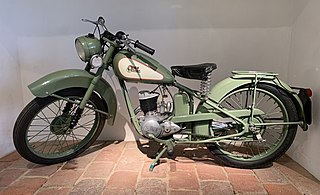
The BSA Bantam is a two-stroke unit construction motorcycle that was produced by the Birmingham Small Arms Company (BSA) from 1948 until 1971. Exact production figures are unknown, but it was between 350,000 and 500,000.

The BSA Gold Star is a motorcycle made by BSA from 1938 to 1963. They were 350 cc and 500 cc single-cylinder four-stroke production motorcycles known for being among the fastest bikes of the 1950s. Being hand-built and with many optional performance modifications available, each motorcycle came from the factory with documented dynamometer test results, allowing the new owner to see the horsepower (bhp) produced.

The Matchless G80 is a single cylinder 500 cc British motorcycle built by Associated Motorcycles (AMC) between 1946 and 1966. During the 1950s and 1960s, the main export product for AMC was the AJS/Matchless range – the road bikes were very similar, often with only the badges distinguishing one marque from the other; the equivalent AJS being the Model 18.
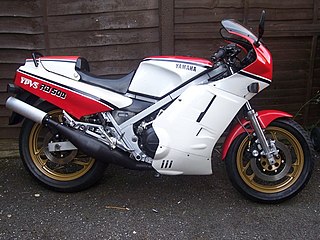
The Yamaha RD500LC is a high-performance, two-stroke sports motorcycle, also known as the RZ500 in Canada and Australia. A lightened but detuned version known as the RZV500R was developed for the Japanese home market. Strict United States Environmental Protection Agency regulations meant that the RZ500 was not available for sale in that country. Produced for a short period between 1984 and 1986 it has become a sought after collector's machine.

The Velocette Thruxton was a sporting motorcycle produced by Velocette between 1965 and 1971. Revealed at the 1964 Earls Court Show, it was the final development of Velocette's antiquated pushrod single, the Venom.

The Velocette Venom was a 499 cc single-cylinder four-stroke British motorcycle made by Velocette at Hall Green in Birmingham. A total of 5,721 machines were produced between 1955 and 1970.
The Velocette MSS is a motorcycle made by Velocette. It was fast, reliable and economical but could not compete against a new range of British twin-cylinder motorcycles. Production ended in 1968.

The BSA A7 was a 500cc motorcycle model range made by Birmingham Small Arms Company (BSA) at its factory in Armoury Road, Small Heath, Birmingham. The range was launched in 1946 using a 495 cc (30.2 cu in) long stroke engine. An improved 497 cc (30.3 cu in) version based on the BSA A10 engine was launched in 1950. The various A7 models continued in production with minor modifications until 1961/2 when they were superseded by the unit-construction A50 model.

The BSA C15 was a 250 cc single-cylinder ohv motorcycle manufactured by the British company BSA from September 1958 until 1967, and was BSA's first four-stroke unit-construction bike. For most of that period, after the introduction of 'Learner Laws' in 1961, a 250 cc was the largest capacity solo machine that a learner could ride unaccompanied when displaying L-plates in the United Kingdom. A road-going Sports derivative was added in 1961, and off-road versions, for Trials and Scrambles, were also available in the range.
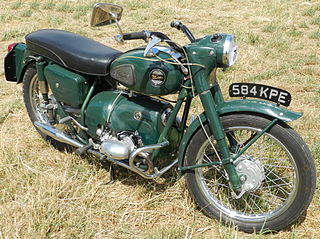
The Velocette Valiant was a British motorcycle produced by Velocette from 1957 to 1963. Launched at the 1956 Earl's Court Motorcycle Show, the Valiant had a 192 cc (11.7cu in) flat-twin engine but was expensive and criticized for its underpowered engine.

The Honda XBR 500 is a 500cc Japanese sports motorcycle launched by Honda in 1985 and in response to the Yamaha SR500. It is powered by a single-cylinder four-valve engine with the valve stem axes arranged radially relative to the geometric centre of the hemispherical combustion chamber - and actuated by rockers and intermediate sub-rockers. Displacing 498 cc (30.4 cu in) and producing 27 or 44 hp, the engine, having its origins in the Honda XR series off-road models, features a "quasi-dry sump", the bulk of the oil being stored in a separate tank below the seat but a proportion of the lubricant remaining in the crankcase sump. The steel-braided hoses connecting the oil tank to the engine are a strong visual element.
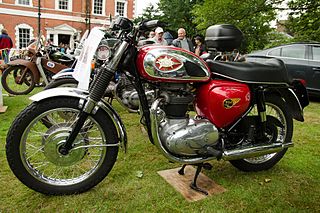
The BSA unit twins were a range of unit construction twin-cylinder motorcycles made by the Birmingham Small Arms Company (BSA) and aimed at the US market. A range of 500 cc (31 cu in), 650 cc (40 cu in) and 750 cc (46 cu in) twins were produced between 1962 and 1972, but they were really developments of the older pre-unit A7/A10 model range with less weight. The engines had a reputation for vibration, but acceleration was good for the time, to a top speed of 100 miles per hour (160 km/h).
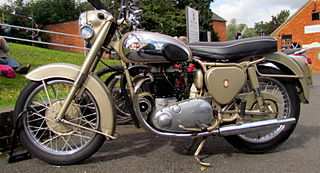
The BSA A10 series was a range of 646 cc (39.4 cu in) air-cooled parallel twin motorcycles designed by Bert Hopwood and produced by Birmingham Small Arms Company at Small Heath, Birmingham from 1950 to 1963. The series was succeeded by the A65 unit construction models.
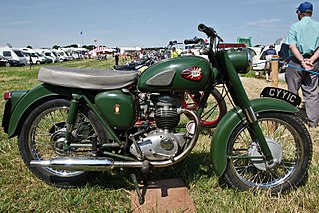
The BSA B40 was a series of 350 cc (21 cu in) unit construction single-cylinder OHV four-stroke motorcycles made by the Birmingham Small Arms Company. Developed from the BSA C15, the machines were produced between 1961 and 1967 for civilian use. Military versions were manufactured from 1967 to 1970. Around 14,000 machines were built in total.

The Suzuki T500, variously known as the Suzuki T500/Five, Suzuki Charger, Suzuki Cobra and the Suzuki Titan during its model life, is a 492 cc (30.0 cu in), two-stroke, twin-cylinder motorcycle produced by the Japanese Suzuki company between 1968 and 1975. The model was developed as a larger version of the Suzuki T20 which was intended to compete with the large-capacity British twins in the American market. When introduced it was Suzuki's largest displacement machine. Overengineering of the engine led to the bike gaining a reputation for reliability, and being virtually bulletproof. A total of over 100,000 units were sold during the model's production.

The Ducati 250 Scrambler, known in Europe as the Ducati 250 SCR is an on/off-road 249 cc (15.2 cu in) single cylinder bevel drive SOHC motorcycle produced by the Italian manufacturer Ducati from 1962 to 1974. Originally produced for the American Market at the request of the US importers, Berliner Motor Corporation, the model was offered in Europe from 1968. Total production was around 12,000 machines.

The Ducati 450 Scrambler, also known in the US as the Ducati Jupiter and in Europe as the Ducati 450 SCR is an on/off-road 436 cc (26.6 cu in) single cylinder bevel drive SOHC motorcycle produced by the Italian manufacturer Ducati from 1969 to 1974. Total production was around 11,000 machines.

The Laverda 750SFC is a hand-built 744 cc (45.4 cu in) air cooled SOHC 4 stroke parallel twin production racing motorcycle produced by the Italian manufacturer Laverda from 1971 to 1976. It was developed from the company's 750SF and drew from the racers used at the 1970 Bol d'Or. Finished in orange with a distinctive half-fairing, the machine was made in batches, with each batch identified by the frame number range. In total 549 SFCs were manufactured.


















